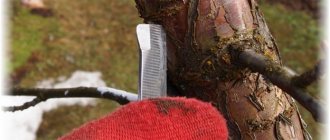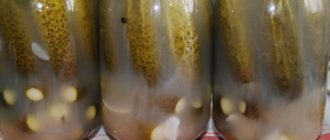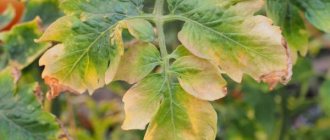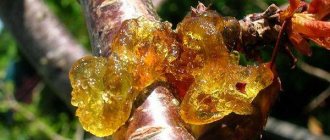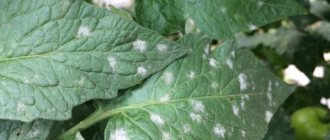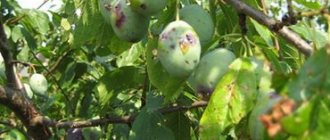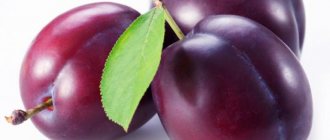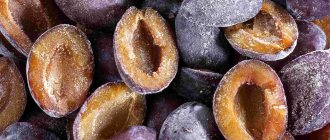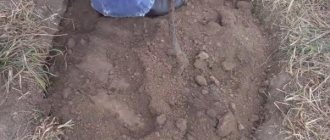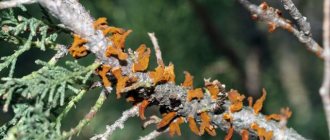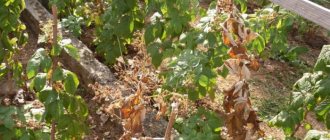Why does the bark of a plum tree crack on its trunk?
There are a number of reasons why the bark of fruit trees cracks. You should inspect the plants in time and identify the causes of cracks.
Factors that can cause cracks to appear in wood:
- harsh winters, frosts;
- damage by rodents;
- harmful insects;
- rapid growth of plum;
- diseases;
- nitrogen overdose;
- a lot of fruits on the tree;
- sunburn;
- excess moisture;
- the tree is planted deep;
- incorrect pruning.
Prevention of cracking of plum bark and trunks
To prevent the appearance of crevices in the bark of a plum tree, you can use whitewash. When carrying out this procedure, it is necessary to maintain the concentration of lime.
When covering young plants with a solution, the concentration of calcium oxide should be less. Accordingly, for old trees it should be larger.
Advice! Such prevention should be carried out twice a year - in spring and autumn. Whitening plums in autumn is the most important.
To prevent frost and sunburn from causing cracks, it is necessary to tie the plum trunk. Many summer residents use newspapers for this. Their paper provides reliable protection from strong winds and sunlight.
Lutrasil and spunbond are also sometimes used for this procedure.
To avoid crevices in the plum bark in the early summer, you need to make small cuts 2 mm deep on it using a sharp, disinfected knife blade. This should be done on the side of the trunk that faces north.
Such operations can be carried out once every five years after the plum tree turns 4 years old.
Specifically for the prevention of black cancer, there are the following tips:
- Choose varieties that are resistant to the disease.
- Remove fallen fruits and leaves from the soil in a timely manner.
- Do not fertilize the ground around the plum tree with bird droppings or manure.
- Carefully trim the branches of the plant.
- Treat cutting areas.
Treatment of diseases, cracks and swelling of the plum trunk
Fresh wounds on a tree attract microbes; viruses, fungi, and various bacteria settle in them. Microorganisms cause plant diseases. The wound grows and spreads infection throughout the tree. The cracks begin to rot; if treatment is not started on time, the entire plum tree will die.
In case of diseases, get rid of the infected surface of the plum trunk. It is necessary to scrape the affected area around the crack using a stiff brush. Collect (under no circumstances leave on the site) and burn infected wood. You can heal the wound with garden putty or varnish. If the crack is not disinfected, it will continue to hurt and increase in size. Before covering, treat the wounds with a solution of potassium permanganate or copper sulfate.
You can prepare the broth yourself:
- take pork, beef, lamb fat, you can replace it with rosin, paraffin or wax;
- add ¼ of the amount of fat flax oil;
- melt the fat, add oil little by little;
- add zinc oxide 20% of the total volume.
If you need a cold-resistant putty, pour ethyl alcohol 1/10 of the total amount into the mixture. The mixture is easy to apply to wood and has a soft consistency.
The bark of a cherry tree burst: what to do and how to treat the tree
The bark of a cherry tree burst: what to do and how to treat the tree
If the bark of a cherry tree bursts, you should not wait for the same to happen to the entire garden. In this material we will tell you how to prevent cracks in trees, and what to do if you still cannot avoid it. Cracks in the bark are harmless only at first glance. If you do not pay attention to them, do not disinfect and cover the wound in time, then fungi can settle in it, which gradually destroys the wood. As a result, a seemingly strong tree can break at the most unexpected moment: due to a sharp gust of wind or when you lean on it to collect a long-awaited harvest.
Why does the bark of fruit trees burst? Cracks in cherries can be the result of several factors. The most common reason is waterlogged soil. As a result of frequent rains, excessive watering or stagnation of groundwater, the plant receives an excess amount of moisture, which accumulates in the unevenly growing bark, and in winter turns into ice and destroys the tree from the inside. Taken from the group vk.com/aidacha Sometimes this leads to the death of cherries, because not only the bark is destroyed, but also the root system gradually dies off due to prolonged excessive moisture.
In addition, cracks on fruit trees can appear as a result of sunburn, especially under the influence of active spring sun. But similar burns with subsequent cracks in the bark also occur in winter. Experienced gardeners claim that most often they appear on trunks on the southwestern side.
Prevention of cracks in the bark of fruit trees First of all, it is important to choose seedlings of frost-resistant varieties that are suitable for growing in your climate zone
When planting fruit trees, pay attention to the location of the root collar. As a rule, it is recommended to leave it above the soil level, otherwise the young tree develops more slowly and, as a result, is less resistant to frost. Choose a planting site carefully
You should not plant a cherry orchard in a lowland area; most likely, nothing good will come of it. To prevent cracking of the bark, you need to monitor the groundwater level. If they are too high, drainage channels can be dug
It is also important not to overdo it with watering the plants.
Sweet cherries especially need watering in May during the period of growing green mass. In June, it is also necessary to moisten the soil around the trees, because... at this time the berries are poured. But during their ripening, it is better to reduce watering, otherwise the fruits may begin to crack. Frequent watering in the second half of summer is also undesirable. This provokes the growth of young shoots and, as a result, can reduce the winter hardiness of the tree. At the same time, autumn moisture-recharging watering shortly before cold weather, on the contrary, helps garden trees to survive the winter.
Do not forget to whiten tree trunks and skeletal branches in time to protect them from overly active sun. For these purposes, you can purchase ready-made preparations in the store or use lime the old fashioned way.
For the winter, trees can be wrapped in burlap or spruce branches. This will help protect them not only from hares, but also from sudden temperature changes. Do not overdo it with nitrogen fertilizers, this can also reduce the winter hardiness of plants and, as a result, increase the likelihood of cracks.
How to treat cracks in the bark If the bark on your cherry tree does burst, you should disinfect the wound by treating it with 1% copper sulfate or Bordeaux mixture, and then cover it with garden varnish.
It is important to observe the tree, because As a result of temperature fluctuations, the crack may increase
New damage should be treated promptly. After some time, a seal (callus) will form around the crack, which will prevent the appearance of new breaks. If the damage is too severe, bridge grafting will help save the tree by restoring sap flow.
Cherry trees whose bark has burst need special attention and timely feeding with complex fertilizers at the beginning of summer. If cracks in the trees in your garden have become widespread, it is best to contact a phytopathologist - a doctor who treats plants.
Loading.
The trunk cracked due to frost
On frosty days, any liquid freezes, and tree sap is no exception. When the sap freezes, it puts pressure on the bark, causing it to expand. At night the liquid freezes, during the day it is warmed by the sun. When wood contracts and expands, it cracks.
The solution to the problem is spring treatment with potassium permanganate or varnish. Summer residents apply sorrel to the wound; it must be cut to release the juice and tied to the damaged area. Leave it for a couple of days, and after a week apply the compress again. Sorrel also helps with gums.
Features and shapes of cracks in the bark
The shape and appearance of the cracks indicate how severely the apple tree's bark is damaged and, in some cases, can indicate the cause of the damage.
Did you know? The area of all apple tree plantings around the world is about 5 million hectares.
Ring wounds
This is the most dangerous type of damage. Sometimes a tree can be saved by grafting with a bridge. The girdling ring deprives all higher parts of the apple tree of nutrition, so the grafting is done below it in early spring. Usually carried out with less than two grafts or one graft for every 5 cm of the trunk. If the tree has sprouted shoots below the damage, then use them.
Grafting behind the bark with a bridge: 1 – trunk of a damaged tree; 2 – cooked cuttings. Bridge grafting with cuttings secured with nails. Grafting behind the bark with a bridge of roots
Transverse and longitudinal cracks
Damage in the form of any, even small cracks should be treated. Longitudinal cracks often appear due to differences in the growth rates of the inner and outer layers or due to temperature differences. Such lesions can heal on their own, but they can become infected. You should take a closer look at them: sometimes they signal serious diseases of the apple tree. Transverse cracks that have an irregular shape on the south side are formed from sunburn.
Small round holes
If very small holes are found on the bark, this indicates the presence of insect pests on the tree. These holes can be produced by the corrosive wood moth, apple glass moth, oriental codling moth, or fragrant wood moth. Small holes can hide significant pest damage, which will subsequently lead to the formation of a hollow.
Wounds and cracks open the way for pathogenic microbes and pests to enter the body of the apple tree
Cracked bark due to rapid tree growth
Rapid development and growth leads to tissue rupture. The surface of the trunk is a fairly elastic material, but intensive growth causes pressure on the tree bark.
The problem may arise from excess fertilization of the soil around the plum tree. You cannot build a toilet next to a plum tree. To correct the situation, reduce the amount of fertilizing and minimize nitrogen additions. The same garden varnish will help to patch up the wounds. The pit with feces should be cleaned and moved to another location.
Prevention of cracks
Preventive measures are aimed at reducing the risk of infection of cherries through cracks. Following simple tips will help prevent the appearance of bursting boles with cracks:
- The choice for planting self-fertile, zoned cherry varieties that are resistant to temperature changes and recurrent frosts.
- Compliance with planting rules is the key to a healthy tree. The cherry grafting site is raised above the ground level, leaving enough space to form a tree trunk circle.
- Cherries grow successfully only on neutral soils that are limed.
- To prevent frost damage, the trunk and skeletal branches of the cherry tree are whitened in autumn and early spring; after the first leaves appear, the procedure is impractical.
- They are tied with bundles of straw, spruce branches or spunbond.
Experienced gardeners furrow the skeletal branches and trunks of cherry trees to avoid cracks and bursting of the surface. The operation is performed on 6-year-old crops, making shallow dotted furrows at intervals of several centimeters. The wounds heal quickly, the wood does not tear the tree as it grows, and the cherry tree rapidly increases in size. For additional tips on preventing and combating burst cherry bark, see the video below.
What to do if the bark cracks due to pests
If you pry the bark with a knife where the wood is cracked and it comes off easily, there is no chance of saving the plum. The tree is cut down and burned. If the bark is hard, the tree can still be saved with the help of chemicals.
Woodworms
Insects live inside the trunk. They live 6-15 years, a pair of pests turns into a huge colony. During its life cycle, one insect breaks through passages up to 30 km long. Pests destroy the tree from the inside, different parts of the trunk burst, and the bark cracks. You can recognize the presence of beetles by the presence of numerous small holes in the wood.
Fighting methods:
- regular tree inspections;
- the pits are treated with chlorophos;
- Woodworms are most active in the spring; they can be caught by hand when found on the trunk;
- the entire bark is coated with a clay solution, the damage is coated with oil paint;
- make traps in the form of large branches to catch females;
- if the situation has not changed, treat with drugs: Confidor Extra, Bi-58.
Sapwood
Horizontal grooves along the entire trunk are a sign of the presence of sapwood on the plum. The beetles make holes up to 1-2 mm in diameter, and the plum begins to produce gum. Insects and their larvae are very dangerous; if measures are not taken in a timely manner, a large number of pests will kill the plant. Adults appear in May; before laying eggs, the female feeds and gnaws the bark at the forks of branches and at the base of the buds. As a result, the buds dry out and the surface of the tree may burst.
Healthy mature plants are able to protect themselves. When passages appear, the plant secretes juice, which floods the passages. This leads to the death of the larvae and limits the access of adults to them.
To destroy sapwood, insecticides are used: Aktara, Vector, Mospilan, Confidor Maxi. The first treatment is done during a mass emergence of bark beetles, approximately after the plum blossoms. After a couple of weeks, the procedure is repeated. The main thing is that all branches and trunk are thoroughly moistened with the solution. Injections under the bark with the following drugs are effective: Decis, Fastak, Arrivo, Sherpa. Use only disposable syringes.
What to do if cracks appear
To remove the damaged area, the trunk is treated with a manganese solution, and the affected layers of bark are removed with a stiff brush. The capillary part is removed with a special garden knife, capturing up to 2 cm of unaffected areas. The cleaned area is treated with copper products, garden varnish is applied, and the trunk is bandaged with cloth. All peeled bark is burned.
If cracks appeared due to the application of nitrogenous fertilizers, severe frosts, or sunburn, the effects are similar. To combat woodworms, Confidor and Bi-58 are used; the pest's passages are treated with chlorophos. In spring, woodworms are active, so they can be caught by hand. To get rid of sapwood, insecticidal agents are used to treat the bark: Confidor Maxi, Aktara, Mospilan. The treatment is carried out 2 times: 1-2 weeks after the tree blooms, the second 2 weeks after the first spraying. You can also inject Decis and Sherpa under the bark with a disposable syringe.
Black cancer is the cause of cracks on plum trunks
A decrease in yield, drying out of branches and foliage, darkening of the bark on the plum may indicate damage to the plum by black cancer, which is caused by a fungus. It penetrates under the bark where the tissue is damaged or weakened. In the southern regions of the country, cancer is more common than in the northern regions.
The spots are small and reddish at first, then enlarge and turn brown. Black spots of rot appear on the fruits. The healthy bark at the border with the diseased tissue is torn and peeled off, forming a crack. In the infected area, the body of the fungus develops and black tubercles appear. A plum can only be saved at the initial stage of the disease.
The main causes of cracks
If tree bark is cracking, the cause of the problem must be determined. This will allow you to choose the appropriate treatment. Possible provoking factors include:
- plant growth is too fast;
- presence of diseases;
- consequences of frost.
Treatment begins as early as possible, before the seedling dies.
Excessive growth
If the plum tree is cracked and the bark on the trunk is peeling off, first of all you need to exclude active growth. The wood inside develops much faster than the outside, and the pressure from inside causes ruptures.
Rapid plant growth is a consequence of improper care. Damage to fruit trees can result from the following errors:
- Abuse of chemical fertilizers does not lead to an improvement in the yield, but to an increase in wood growth activity. Nitrogen fertilizers cannot be added during the period of active fruit ripening. Moreover, you cannot use them if the bark on the trunk is cracked.
- Excessive watering provokes the rapid formation of wood, during which the bark does not have time to adapt and begins to crack.
By eliminating the above factors, the occurrence of cracks can be prevented.
Important! Wounds on the bark may heal on their own over time. But damage becomes a gateway for infection and pests to enter. Less common causes of bark cracking include planting too deep
The seedling may not be adapted to the climatic conditions of a certain region and respond to this with active growth
Less common causes of bark cracking include planting too deeply. A seedling may not be adapted to the climatic conditions of a certain region and may respond to this with active growth.
By eliminating all of these factors, you can stop cracking and also prevent its reappearance. If all recommendations are followed, the damage will heal into the next season.
Plum diseases
If the bark of young fruit trees is actively bursting, then most likely the cause is the appearance of a disease. Black cancer on plums is more likely; a photo will help you easily identify its signs. Cracking is one of the symptoms of a dangerous lesion.
Important! Treatment of black cancer should begin as early as possible. If this is not done, the disease will destroy the entire garden. A plant with black cancer sheds its leaves and does not bear fruit.
The branches are drying up. The surface of the bark not only cracks, it becomes several times darker. Foci of fungal infections appear. Possible causes of the disease include:
A plant with black cancer sheds its leaves and does not bear fruit. The branches are drying up. The surface of the bark not only cracks, it becomes several times darker. Foci of fungal infections appear. Possible causes of the disease include:
- improper use of fertilizers;
- planting a plant near an outdoor toilet;
- exposure of the site from winds;
- general neglect of the site;
- proximity to compost pits.
Small dark dots are visible around the ulcers of black cancer. They can be viewed with a magnifying glass. Dark rot appears on the trunk. The disease affects the plant itself and the fruits. Symptoms usually appear during transport and storage.
Gradually, dark spots appear on the fruits, which first increase in size and then cover the entire plum. The harvest is unfit for consumption; often you have to throw away all the collected fruits.
The risk of damage by pests cannot be excluded. When a tree trunk bursts, you should suspect woodworm. Insects live 5-14 years.
Even a few parasites, if left untreated, can grow into a huge colony. The beetles destroy the plum from the inside, causing different sections of the trunk to burst. The pest can be recognized by a large number of small holes in the bark.
If the plum trunk is cracked, the appearance of sapwood cannot be ruled out. The pest leads to the appearance of gum. The insect completely destroys the plant if treatment is not started in a timely manner. The surface of the trunk actively bursts, the buds dry out. The existing cracks resemble a laceration, and the volume of damage is constantly increasing in size.
Consequences of frost
The tree may have been frozen. If there are severe winters in the planting area, then choose winter-hardy varieties of plums. Care activities are carried out not only in the summer, but also before wintering. Cracking usually begins after the temperature rises. A damaged plant is susceptible to the appearance of parasites.
What to do
If this problem is not solved in a timely manner, pathogenic bacteria, as well as larvae of harmful insects, accumulate in the cracks. This may negatively affect the growth of the tree.
To treat sunburn, you need to use an iron scraper to remove dead tissue.
Important!
It is necessary to work with the tool carefully so as not to damage healthy tissue.
Then soak the cloth in the Bordeaux mixture and moisten the tree bark. After 2 - 3 hours, the wound on the bark must be treated with garden varnish. To prepare it, beeswax, sulfur and lighter gasoline are mixed. Dissolve the mixture in a water bath and stir.
If the cracks are formed as a result of the influence of rodents, such plants must be pruned short in early spring. Treat the damaged areas with a weak solution of potassium permanganate, and then lubricate with garden varnish. Such trees require special care and attention. This is necessary for the tree to gain strength and become stronger after damage.
If the cause of the formation of cracks is damage to the hyaloderm by insects, experienced gardeners recommend establishing the degree of damage to the bark. To do this, carefully pierce the wood with a knife. If healthy and hard areas are felt underneath, the plant can still be saved. To do this, an iron scraper is used to remove old and damaged bark, under which not only insects, but also their larvae accumulate. After this, the tree trunk is treated with preparations such as Kanfidor, Calypso or Antizhuk. If deep cracks are visible on the trunk, the drug is injected into them with a syringe. After a few days, the tree trunk needs to be whitened with lime.
The trees need to be whitened with lime
If large cracks have formed on the plant (more than 10 cm wide), it is more difficult to help it. After removing the old bark, you need to put a layer of a mixture of clay and cow dung on the wound. The lubricated area is wrapped in plastic film, which is fixed to the stem with a rope. This will help prevent the mixture from drying out.
Advice!
You can also use Nitrol. This is machine oil that helps get rid of cracks in the bark in a few months.
Often, during severe frosts, frost cracks can form in the bark of a tree. They take much longer to heal. To do this, experienced gardeners recommend adhering to the following recommendations:
- It is better to start treatment in the summer.
- Remove any damaged or dead bark using an iron scraper.
- Treat cracks with 5% copper sulfate.
- After the solution has dried, lubricate the damaged area with garden varnish.
- If the wound is large, the tree trunk is tightened with strong wire. This will help speed up the healing process of the crack.
Sometimes the cause of cracks is infection with black cancer. The disease is caused by a pathogenic fungus whose spores spread quite quickly. Symptoms of the disease are the appearance of purple spots on the bark, which gradually turn into cracks. To treat such a plant, it is necessary to remove the old hyaloderm and disinfect the affected area. To do this, you can use Bordeaux mixture, copper sulfate or potassium permanganate solution. 2 - 3 hours after this, the treated area is smeared with garden varnish. If the degree of damage to the bark does not allow removing the diseased area, experienced gardeners recommend destroying the plant. This will prevent infection of other fruit trees in the garden.
Tree care is important
